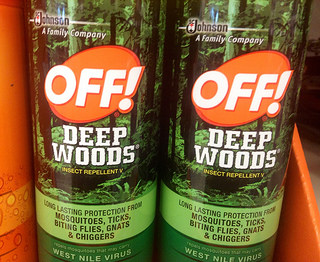Do Insect Repellents Work Against Ticks?
By Chris Williams on August 25, 2014.
I’m worrying a lot lately about ticks since I know several people who have had Lyme disease. I know we should use repellent when we are outside, but what kind? Does a regular mosquito repellent like Off! work against ticks? P. D., Ayer, MA
 Most insect repellents for mosquitoes and biting flies are also labeled for use against ticks, but repellency of the product for ticks is usually less than for mosquitoes. They are, after all, insect repellents, and ticks are not insects. There is less testing data for repellents against ticks. Some products that are labeled for use against ticks have the words “tick repellent” in their name.
Most insect repellents for mosquitoes and biting flies are also labeled for use against ticks, but repellency of the product for ticks is usually less than for mosquitoes. They are, after all, insect repellents, and ticks are not insects. There is less testing data for repellents against ticks. Some products that are labeled for use against ticks have the words “tick repellent” in their name.
DEET is Still the Repellent of Choice
While most insect repellents will work to some degree against ticks, two chemicals are generally recommended: DEET and permethrin. The repellent ingredient DEET is available in many different retail products such as Off!, Cutter, and Repel. It’s been in use for decades, has an excellent safety record, and is still the most effective of the personal repellents. Studies indicate that DEET will repel ticks and may prevent attachment, but it doesn’t provide total protection against Ixodes scapularis, the tick that transmits Lyme disease. The American Academy of Pediatrics recommends that repellents used on children contain 10% or less DEET.
Treat Outdoor Clothing for Double Tick Protection
Permethrin is for use only on clothing, not skin. When applying a repellent against ticks, pay particular attention to shoe tops, socks, and the lower portion of pants. Ticks crawl upwards. Cutter Outdoorsman Gear Guard is one permethrin product. Permethrin on clothing will generally survive through several washings. The two products together, DEET on exposed skin and permethrin on clothes, is an outstanding combination against ticks and biting insects.
Be sure to check the repellent’s label for the ingredient you are seeking. For instance, not all Cutter products contain DEET. Cutter also has products with picaridin as the repellent ingredient and others containing MGK-326 or MGK-264, all of which are approved repellents. Read the label directions regarding precautions and re-application times.
Check for Ticks After Every Outdoor Excursion
After you or your children are finished playing outdoors, bathe to remove repellent from the skin. Use this time to do a thorough body check for crawling or attached ticks. Remember that immature ticks can be very tiny. Attached ticks must be removed as soon as possible since ticks must be attached for a certain period of time in order to transmit Lyme disease. See “Don’t Put Off Removing That Tick!” for instructions on how best to remove an attached tick.
Photo credit: JeepersMedia / Foter / Creative Commons Attribution 2.0 Generic (CC BY 2.0)